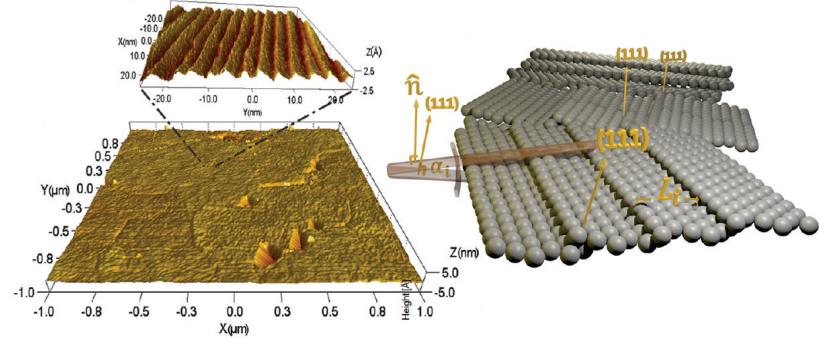Self-formation of atomic steps on solid surfaces has been the subject for many research over the years. Controlling the formation of these structures is desirable due to their well-arranged nano-structure arrays of atomic steps, which are too small to produce by other advanced lithography techniques. Highly ordered arrays of atomic steps are useful as templates for fabrication of nano-structures such as nano-wires, nano-dots, etc. Atoms located at the steps edges have low coordination number and act as preferred adsorption sites as they are much more reactive and can function as catalytic agents. They are also used in microelectronics applications and for assembling self-assembled monolayers, graphene and C60.
These arranged atomic steps surfaces are commonly referred in the literature as "vicinal surfaces". The classic method for vicinal surfaces fabrication is miscut of single crystal of metal or semiconductor in a small angle to a high-symmetry plane. The achieved surface is high-indexed and thus has higher surface energy. Seeking to lower the surface energy, atomic steps are formed with low-index plane upon them during annealing. The periodicity and step width is controlled by the miscut angle.
Recently a new less expensive and time-consuming method of producing vicinal-like surfaces has been developed at Prof. Boaz Pokroy’s lab. The vicinal-like surfaces are formed by using template stripping method which reveals the interface between the thin metal film and the supporting substrate.
 Figure 1: (right side) Schematic illustration of the vicinal-surface-like atomic structure. (Left side) STM images of stripped gold surfaces from SiO2 substrates. The thin gold films were annealed at low temperatures prior to template stripping.
Figure 1: (right side) Schematic illustration of the vicinal-surface-like atomic structure. (Left side) STM images of stripped gold surfaces from SiO2 substrates. The thin gold films were annealed at low temperatures prior to template stripping.
Publications:
Chen L, Koifman Khristosov M, Saguy C, Katsman A and Pokroy B. Association between gold grain orientation and its periodic steps formed at the gold/substrate interface. J Phys Chem C 2018;122:11364.
Borukhin S, Saguy C, Koifman M, & Pokroy B. Self-Ordered Vicinal-Surface-Like Nanosteps at the Thin Metal-Film/Substrate Interface. J Phys Chem C 2012, 116(22):12149.
Borukhin S, & Pokroy B. Formation and elimination of surface nanodefects on ultraflat metal surfaces produced by template stripping. Langmuir 2011, 27(22):13415.

